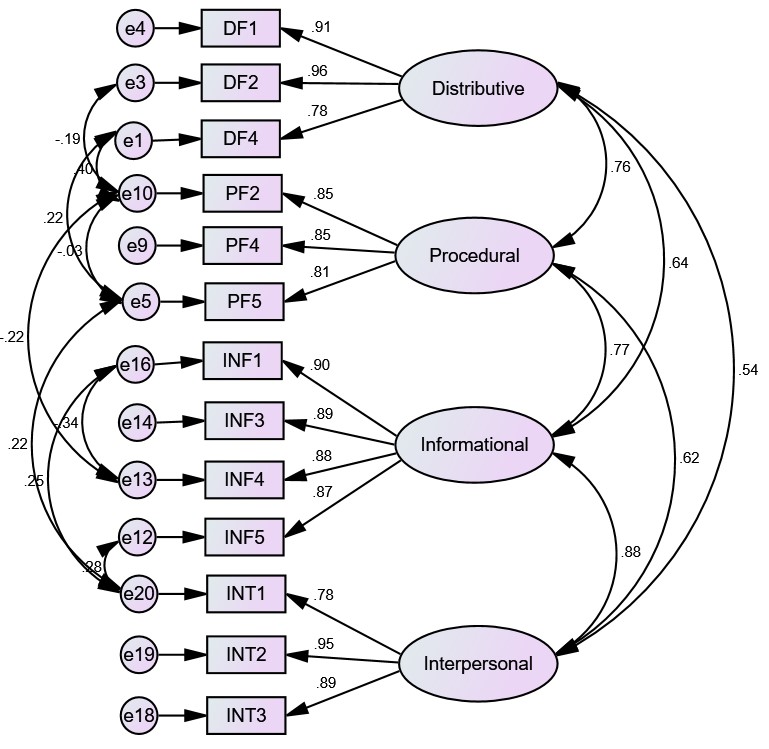การตรวจสอบโครงสร้างของความเป็นธรรมองค์กร
คำสำคัญ:
ความเป็นธรรมขององค์กร, ความตรงเชิงโครงสร้าง, ความเป็นธรรม, การวิเคราะห์องค์ประกอบเชิงยืนยัน, CFAบทคัดย่อ
การวิจัยครั้งมีวัตถุประสงค์เพื่อศึกษาแนวคิดทฤษฏีมิติของความเป็นธรรมและทดสอบความตรงเชิงโครงสร้างของการวัดความเป็นธรรม ในการวัดความเป็นธรรมขององค์กรจะช่วยให้ผู้จัดการเข้าใจและจัดการความสัมพันธ์ของพนักงานได้ดียิ่งขึ้น ทั้งนั้ผู้วิจัยได้ใช้วิธีภาวะน่าจะเป็นสูงสุด โดยใช้โปรแกรม AMOS 22.0 ทำการประเมินความตรงเชิงโครงสร้างของการวัดและกำหนดเพื่อตรวจสอบว่าข้อคำถามสะท้อนถึงตัวแปรจริงหรือไม่ ผลการวิจัยแสดงให้เห็นว่า 5 รูปแบบที่ทำการวิเคราะห์เสร็จสมบูรณ์ของความเป็นธรรมขององค์กร รูปแบบของการประเมินได้ทำการวิเคราะห์และประเมินผลซ้ำแล้วซ้ำอีกเพื่อตรวจสอบนำมาปรับปรุงในรูปแบบทุกครั้งที่ได้ทำการประเมินและวิเคราะห์เสร็จสิ้น ในรูปแบบสุดท้ายได้ทำการตัด 7 ข้อคำถาม ดังนั้นจึงมี 13 ข้อคำถามที่ได้นำมาทำการวิเคราะห์องค์ประกอบเชิงยืนยันที่ได้ทำการยอมรับ 4 ปัจจัยการวัดในโครงสร้างนี้ได้แก่ การกระจายความเป็นธรรม การกระบวนการความเป็นธรรม ความสัมพันธ์ระหว่างบุคคล และความเป็นธรรมการให้ข้อมูล ทั้งนี้ผู้วิจัยยังมีการสนับสนุนในวาทกรรมเชิงวิชาการในตัวแปรความเป็นธรรมขององค์กรและดำเนินการจัดให้เป็นหลักฐานเชิงประจักษ์
References
Adams, J. S. (1965) ‘Inequity in social exchange’, in L. Berkowitz (ed.), Advances in experimental social psychology, vol. 2, pp. 267–299, New York, NY: Academic Press.
Anderson, J. C., & Gerbing, D. W. (1988) Structural equation modeling in practice: A review and recommended two-step approach, Psychological Bulletin, vol. 103, no. 3, pp. 411-423.
Aquino, K. (1995) Relationships among pay inequity, perceptions of procedural fairness, and organizational citizenship, Employee Responsibilities and Rights Journal, vol. 8, no. 1, pp. 21–33.
Bagozzi, R. P., & Yi, Y. (1988) On the evaluation of structural equation models, Journal of the Academy of Marketing Science, vol. 16, no. 1, pp. 74-94.
Bentler, P. M. (1990) Comparative fit indexes in structural model, Psychological Bulletin, vol. 107, no. 2, pp. 238-246.
Bies, R. J., & Moag, J. S. (1986) ‘Interactional justice: Communication criteria of fairness’, in R. J. Lewicki, B. H. Sheppard & M. H. Bazerman (eds), Research on negotiation in organizations, vol. 1, pp. 43-55, Greenwich, CT: JAI Press.
Blau, P. (1964) Exchange and power in social life, New York, NY: Wiley.
Blodgett, J. G., et al. (1997) The effects of distributive, procedural, and interactional fairness on postcomplaint behavior, Journal of Retailing, vol. 73, no. 2, pp. 185-210.
Brown, J. R., et al. (2006) The roles played by interorganizational contracts and fairness in marketing channel relationship, Journal of Business Research, vol. 59, no. 2, pp. 166-175.
Brown, M. W., & Cudeck, R. (1992) Alternative ways of assessing model fit, Sociological Methods & Research, vol. 21, no. 2, pp. 230-258.
Castaño, A. M., & García-Izquierdo, A. L. (2018). Validity evidence of the Organizational Justice Scale in Spain. Psicothema, (30.3), 344–350. https://doi.org/10.7334/psicothema2017.415
Chase, S. (2018) In search of individual and organisational fairness in policing, International Journal of Human Resource Development: Practice, Policy & Research, vol. 3, no. 1, pp. 7-21, doi: 10.22324/ijhrdppr.3.102
Cohen-Charash, Y., & Spector, P. E. (2001) The role of fairness in organizations: A meta-analysis, Organizational Behavior and Human Decision Processes, vol. 86, no. 2, pp. 278-321.
Colquitt, J. A. (2001) On the dimensionality of organizational justice: A construct validation of a measure, Journal of Applied Psychology, vol. 86, pp. 386–400.
Colquitt, J. A., Conlon, D. E., Wesson, M. J., Porter, C., & Yee Ng, K. (2001) Justice at the millennium: A meta-analytic review of 25 years of organizational justice research, Journal of Applied Psychology, vol. 86, pp. 425–445.
Colquitt, J. A., Scott, B. A., Rodell, J. B., Long, D. M., Zapata, C. P., Conlon, D. E., & Wesson, M. J. (2013). Justice at the millennium, a decade later: A meta-analytic test of social exchange and affect-based perspectives. Journal of Applied Psychology, 98(2), 199–236. https://doi.org/10.1037/a0031757
Croonen, E. (2010). Trust and fairness during strategic change processes in franchise systems, Journal of Business Ethics, vol. 95, no. 2, pp. 191-209.
Cropanzano, R. S., & Ambrose, M. L. (2015). Organizational Justice. In R. S. Cropanzano & M. L. Ambrose (Eds.), The Oxford Handbook of Justice in the Workplace.
Cropanzano, R., & Molina, A. (2015) ‘Organizational justice’, in J. D. Wright (ed.), International encyclopedia of the social & behavioral sciences, 2nd edition, pp. 379–384, Amsterdam, Netherlands: Elsevier.
Cropanzano, R., et al. (2002) Using social exchange theory to distinguish procedural from interactional fairness, Group & Organization Management, vol. 27, no. 3, pp. 324-351.
Devlin, J. F., Roy, S. K., & Sekhon, H.S., (2014). Perceptions of fair treatment in financial services: development, validation and application of a fairness measurement scale, European Journal of Marketing, vol. 48, no. 7/8, pp. 1315-1332.
Fornell, C., & Larcker, D. F. (1981) Evaluating structural equation models with unobservable variables and measurement error, Journal of Marketing Research, vol. 18, no. 1, pp. 39-50.
Greenberg, J. (1987) A taxonomy of organizational fairness theories, Academy of Management Review, vol. 12, no. 1, pp. 9–22.
Greenberg, J. (1990) Organizational fairness: Yesterday, today, and tomorrow, Journal of Management, vol. 16, no. 2, pp. 399-432.
Greenberg, J. (1993) ‘The social side of fairness: Interpersonal and informational classes of organizational justice’, in R. Cropanzano (ed.), Justice in the workplace: Approaching fairness in human resource management, pp. 79-103, Hillsdale, NJ; Lawrence Erlbaum Associates.
Greenberg, J. (2011) Organizational justice: The dynamics of fairness in the workplace. In APA Handbooks in Psychology®. APA handbook of industrial and organizational psychology, Vol 3: Maintaining, expanding, and contracting the organization. (pp. 271–327). https://doi.org/10.1037/12171-008
Hair, J. F., et al. (2006) Multivariate data analysis, Saddle River, NJ: Pearson Prentice Hall.
Hair, J. F., Black, W. C., Babin, B. J., & Anderson, R. E. (2010) Multivariate data analysis: A global perspective. (7th ed). New Jersey: Pearson Education Inc.
Hoe, S. L. (2008) Issues and Procedures in Adopting Structural Equation Modeling Technique. Journal of Applied Quantitative Methods, 3, 76-83.
Hoelter, J. W. (1983) The analysis of covariance structures: Goodness-of-fit indices, Sociological Methods and Research, vol. 11, pp. 325–344.
Hofstede, G., Hofstede, G. J., & Minkov, M. (2010) Cultures and organizations: Software of the mind ; intercultural cooperation and its importance for survival (Rev. and expanded 3. ed). New York: McGraw-Hill.
Jawahar, I. a. (2006) Perceived organizational support for women's advancement and turnover intentions: The mediating role of job and employer satisfaction. Women in Management review, 21(8), 643–661.
Konovsky, M. A. (2000) Understanding procedural fairness and its impact on business organizations, Journal of Management, vol. 26, no. 3, pp. 489-511.
Kumar, N., et al. (1995) The effects of supplier fairness on vulnerable resellers, Journal of Marketing Research (JMR), vol. 32, no. 1, pp. 54-65.
Kuvaas, B. (2010) The interactive role of performance appraisal reactions and regular feedback. Journal of Managerial Psychology. 26(2), 123-127.
Kyriazos, T. A. (2018) Applied Psychometrics: Sample Size and Sample Power Considerations in Factor Analysis (EFA, CFA) and SEM in General. Psychology, 09(08), 2207–2230.
Leventhal, G. S. (1976) ‘The distribution of rewards and resources in groups and organizations’, in L. Berkowitz & W. Walster (eds.), Advances in experimental social psychology, vol. 9, pp. 91–131, New York, NY: Academic Press.
Leventhal, G. S. (1980) ‘What should be done with equity theory? New approaches to study of fairness in social relationship’, in K. Gergen, M. Greenberg & R. Willis (eds.), Social exchange: Advances in theory and research, pp. 27-55, New York: Plenum Press.
Liao, H., & Rupp, D. E. (2005) The impact of fairness climate and fairness orientation on work outcomes: A cross-level multifoci framework, Journal of Applied Psychology, vol. 90, pp. 242-256.
Liu, Y., et al. (2012) How does fairness matter in achieving buyer-supplier relationship performance?, Journal of Business Research, vol. 30, no. 5, pp. 355-367.
Luo, Y. (2007) The independent and interactive roles of procedural, distributive, and interactional fairness in strategic alliances, Academy of Management Journal, vol. 50, no. 3, pp. 644-664.
Luo, Y., et al. (2015) Improving performance and reducing cost in buyer–supplier relationships: The role of justice in curtailing opportunism, Journal of Business Research, vol. 68, no. 3, pp. 607–615.
Malhotra, N. K., & Birks, D. F. (2007) Marketing research: An applied approach (3. edition). Harlow, England London New York Boston San Francisco Toronto Sydney Singapore Hong Kong Tokyo Seoul Taipei, New Delhi Cape Town Madrid Mexico City Amsterdam Munich Paris Milan: Financial Times Prentice Hall.
Mayer, D., Nishii, L., Schneider, B., & Goldstein. H. (2007) The precursors and products of fairness climates: group leader antecedents and employee attitudinal consequences. Personnel Psychology, 60(4), 929-963.
Miller, B. K., Konopaske, R., & Byrne, Z. S. (2012) Dominance analysis of two measures of organizational justice. Journal of Managerial Psychology, 27(3), 264–282.
Moorman, R. H. (1991) Relationship between organizational justice and organizational citizenship behaviors: Do fairness perceptions influence employee citizenship?, Journal of Applied Psychology, vol. 76, pp. 845–855.
Nakane, C. (2008) Japanese Society (Renewed ed., repr). Berkeley, Calif.: Univ. of California Press.
Narasimhan, R., et al. (2013) An investigation of fairness in supply chain relationships and their performance impact, Journal of Operations Management, vol. 31, no. 5, pp. 236-247.
Niehoff, B. P., & Moorman, R. H. (1993) Justice as a mediator of the relationship between methods of monitoring and organizational citizenship behavior, Academy of Management Journal, vol. 36, pp. 527-556.
Nunnally, J. (1978) Psychometric theory, 2nd edition, New York: McGraw-Hill.
Park, H., Lee, K.-S., Park, Y.-J., Lee, D.-J., & Lee, H.-K. (2018). Reliability and validity of the Korean version of organizational justice questionnaire. Annals of Occupational and Environmental Medicine, 30(1), 26. https://doi.org/10.1186/s40557-018-0238-8
Pérez-Arechaederra, D., Briones, E., Lind, A., & García-ortiz., L. (2014) Perceived organizational justice in care services creation and multi sample validation of a measure. Social Science & Medicine, 102, 26-32.
Scheer, L. K., Kumar, N., & Steenkamp, Jan-Benedict, E. M. (2003) Reactions to perceived inequity in US and Dutch interorganizational relationships, Academy of Management Journal, vol. 46, no. 3, pp. 303-316.
Shaikh, A. (2016) Conceptualizing fairness in franchisor–franchisee relationship: Dimensions, definitions and preliminary construction of scale, Journal of Retailing and Consumer Services, vol. 28, pp. 28–35.
Shaikh, A., Biswas, S. N., Yadav, V., & Mishra, D. (2017) Measuring fairness in franchisor-franchisee relationship: a confirmatory approach. International Journal of Retail & Distribution Management, 45(2), 158–176.
Shapiro, D. L. & Kirkman, B. L. (1999) Employees' reaction to the change to work teams: The influence of "anticipatory" injustice. Journal of Organizational Change Management, 12(1), 51–66.
Singh, K., Junnarkar, M., & Kaur, J. (2016) Measures of Positive Psychology, Development and Validation. Berlin: Springer
Tabachnick, B. G., & Fidell, L. S. (2007) Using Multivariate Statistics (5th ed.). New York: Allyn and Bacon.
Thibaut, J. W., & Walker, L. (1975) Procedural fairness: A psychological analysis, Hillsdale, NJ: Lawrence Erlbaum Associates.
Trada, S., & Goyal, V. (2017) The dual effects of perceived unfairness on opportunism in channel relationships, Industrial Marketing Management, vol. 64, pp. 135–146.

Downloads
เผยแพร่แล้ว
How to Cite
ฉบับ
บท
License
Copyright (c) 2022 https://creativecommons.org/licenses/by-nc-nd/4.0/

This work is licensed under a Creative Commons Attribution-NonCommercial-NoDerivatives 4.0 International License.


